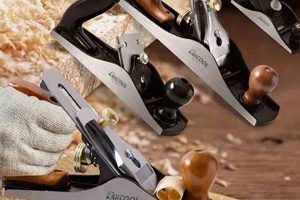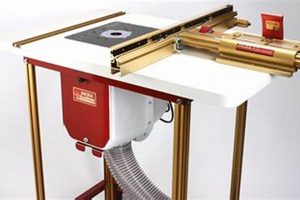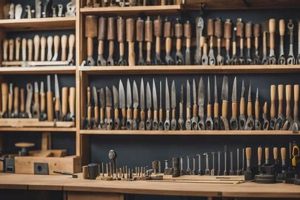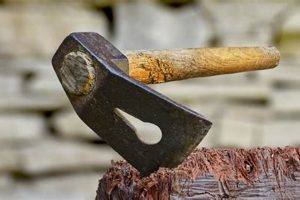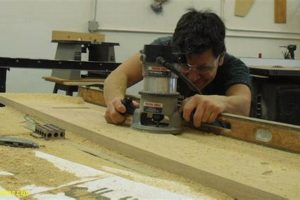Equipment utilized in the shaping and fabrication of wood products within industrial settings is the focus of this article. These specific implements are integral to processes ranging from initial stock preparation to final finishing, often incorporating advanced technologies for precision and efficiency. An example includes automated systems for cutting, edging, and surface treatment of timber and composite wood materials.
The significance of such implements lies in their capacity to enhance productivity, ensure consistent quality, and minimize material waste within woodworking operations. Historically, advancements in this equipment have driven innovation in furniture manufacturing, construction, and various other sectors relying on wood-based components. Improvements in automation, safety features, and energy efficiency contribute to sustainable and economically viable manufacturing practices.
The subsequent sections will delve into specific categories of machinery, examining their applications, operational characteristics, and the evolving landscape of technological advancements that shape their functionality and performance within modern woodworking environments.
Operational Guidance for Industrial Woodworking Equipment
The following guidance emphasizes optimal utilization and longevity of advanced woodworking machinery within professional environments. Diligent adherence to these points promotes efficiency and safety.
Tip 1: Implement Regular Preventative Maintenance: A schedule encompassing lubrication, filter replacement, and component inspection mitigates unforeseen downtime and costly repairs. Consult the manufacturer’s guidelines for specific intervals and procedures.
Tip 2: Prioritize Operator Training: Comprehensive instruction on machine operation, safety protocols, and troubleshooting is paramount. Skilled personnel are essential for maximizing equipment performance and minimizing the risk of accidents.
Tip 3: Optimize Material Handling Procedures: Efficient material flow reduces strain on equipment and enhances overall productivity. Implement systems for automated loading, unloading, and workpiece conveyance.
Tip 4: Ensure Proper Dust Extraction: Wood dust poses health and safety hazards. Invest in a robust dust extraction system to maintain a clean and safe working environment, and to prevent damage to machinery components.
Tip 5: Calibrate Equipment Regularly: Precise calibration is crucial for maintaining accuracy and achieving desired dimensional tolerances. Employ specialized tools and techniques to verify and adjust machine settings periodically.
Tip 6: Monitor Performance Metrics: Track key performance indicators (KPIs) such as cycle times, material waste, and downtime. This data facilitates identification of areas for improvement and optimization of processes.
Tip 7: Utilize Genuine Replacement Parts: Employing authentic components ensures compatibility and maintains the integrity of the equipment. Counterfeit or substandard parts can compromise performance and safety.
Adherence to these recommendations fosters a productive and safe operational environment, maximizing the return on investment in advanced woodworking technology. This provides a solid foundation for sustained growth and competitiveness within the industry.
The subsequent analysis will explore the future trends influencing the development and application of these technologies.
1. Precision
The operational effectiveness of industrial-grade woodworking equipment is inextricably linked to its precision capabilities. Deviation from specified dimensional tolerances directly impacts the quality of the final product, potentially leading to structural weaknesses, aesthetic imperfections, and functional deficiencies. Consider, for example, the creation of interlocking components for cabinetry. Even minute errors in cut angles or dimensions can result in misaligned joints, compromised structural integrity, and the need for costly rework or material waste. Consequently, the ability to consistently achieve high degrees of accuracy is a primary determinant of the value and utility of such machinery.
Modern equipment incorporates advanced technologies to enhance and maintain precision. Computer Numerical Control (CNC) systems, for instance, provide automated control over toolpaths and cutting parameters, minimizing the potential for human error. Laser-guided systems offer enhanced accuracy in aligning workpieces and verifying dimensions. Furthermore, closed-loop feedback mechanisms constantly monitor and adjust machine settings to compensate for variations in material density, tool wear, and environmental conditions. These features are not merely desirable add-ons; they are integral components necessary for meeting the stringent demands of contemporary woodworking manufacturing.
In summation, precision is not simply a characteristic of woodworking equipment; it is a foundational requirement for achieving consistent quality, minimizing waste, and ensuring structural integrity. The integration of advanced technologies designed to enhance and maintain accuracy represents a critical investment for manufacturers seeking to optimize their operations and meet the increasingly exacting standards of the marketplace. The failure to prioritize precision inevitably leads to reduced efficiency, increased costs, and a compromised final product.
2. Durability
The capacity of industrial woodworking equipment to withstand prolonged and demanding operational conditions is paramount. This inherent characteristic, known as durability, directly influences the long-term viability and return on investment for manufacturing facilities. The equipment’s ability to maintain its performance specifications under continuous use, exposure to dust and debris, and fluctuating environmental conditions determines its operational lifespan and susceptibility to costly breakdowns. For instance, a poorly constructed edgebander, susceptible to premature wear on its feed rollers or glue application system, will necessitate frequent repairs and replacements, thereby disrupting production schedules and increasing operational expenses. Consequently, durability is not merely a desirable feature; it is a fundamental prerequisite for sustained productivity and profitability.
The construction materials, engineering design, and manufacturing processes employed in the creation of these implements directly affect their ability to endure rigorous operational demands. The utilization of high-strength alloys, hardened steel components, and robust bearing systems contributes to enhanced resistance against wear, corrosion, and mechanical stress. Moreover, the incorporation of protective measures, such as sealed enclosures for critical components and integrated lubrication systems, further mitigates the detrimental effects of dust, moisture, and frictional forces. For example, a CNC router featuring a rigid machine frame and high-quality linear guides will exhibit greater stability and precision over extended periods, minimizing the need for recalibration and component replacement.
In conclusion, durability is a critical attribute that significantly impacts the overall value proposition of industrial woodworking equipment. By prioritizing robust construction, employing durable materials, and implementing effective protective measures, manufacturers can ensure that their equipment withstands the rigors of continuous operation, thereby maximizing productivity, minimizing downtime, and achieving a superior return on investment. The long-term cost-effectiveness of such machinery is inextricably linked to its capacity to maintain its performance integrity under demanding operational conditions.
3. Automation
The integration of automation within industrial woodworking processes represents a significant advancement in efficiency and precision. Modern woodworking equipment frequently incorporates automated features to streamline operations, minimize manual intervention, and enhance overall productivity. The utilization of Computer Numerical Control (CNC) systems, automated material handling systems, and robotic assembly lines exemplifies this trend. As a result, the equipment is capable of performing complex tasks with minimal human oversight, leading to reduced labor costs, increased throughput, and improved consistency in output quality. Automation also mitigates the risk of human error, thereby reducing material waste and rework requirements. Equipment examples might include automated panel saws with optimized cutting patterns or robotic sanding systems that ensure uniform surface finishing.
A critical aspect of automation is its impact on the skill sets required of operators. While automation reduces the need for manual dexterity, it necessitates a greater understanding of programming, machine maintenance, and process optimization. Personnel must be trained to effectively manage and troubleshoot automated systems, interpret data from machine sensors, and make informed decisions to maintain optimal performance. The implementation of automated equipment, therefore, necessitates a corresponding investment in employee training and development. Moreover, automation enables the integration of data collection and analysis tools, allowing manufacturers to monitor key performance indicators, identify bottlenecks, and implement continuous improvement strategies. This data-driven approach to process management is essential for maximizing the benefits of automation.
In summary, automation plays a pivotal role in modern industrial woodworking operations, driving improvements in efficiency, precision, and cost-effectiveness. While the integration of automated equipment requires a strategic approach to workforce development and process management, the potential benefits are substantial. The continued advancement of automation technologies will undoubtedly shape the future of the woodworking industry, enabling manufacturers to meet the increasing demands for high-quality, customized products in a competitive global marketplace.
4. Versatility
The adaptability of implements to accommodate a spectrum of tasks and materials defines their versatility. This attribute is paramount in modern woodworking operations, where manufacturers must cater to diverse product specifications and fluctuating market demands. Versatile equipment offers a significant advantage by reducing the need for specialized machinery, thereby minimizing capital expenditure and maximizing floor space utilization. The operational scope extends beyond mere task completion; it encapsulates the capacity to seamlessly transition between dissimilar projects, augmenting overall manufacturing agility.
- Material Compatibility
The ability to process various wood species, composite materials, and engineered wood products is a key facet of versatility. Equipment designed to handle hardwoods, softwoods, laminates, and veneers without requiring extensive modifications or adjustments enhances operational flexibility. Failure to accommodate diverse materials necessitates the acquisition of specialized machinery or compromises product quality. A universal feeder can handle multiple thickness and width without requiring setup changes.
- Configurability for Diverse Operations
Implements that can be readily reconfigured to perform a range of woodworking tasks, such as sawing, shaping, drilling, and sanding, demonstrate versatility. Modular designs and interchangeable tooling systems enable swift adaptation to evolving production requirements. This minimizes downtime associated with machine changeovers and enhances overall efficiency. For instance, a machining center capable of both routing and drilling operations eliminates the need for separate machines.
- Adaptability to Varying Batch Sizes
Equipment capable of efficiently processing both large production runs and small custom orders exhibits adaptability. Machines with programmable settings and automated setup procedures can facilitate rapid changeovers between different batch sizes, ensuring optimal throughput regardless of order volume. A saw can switch to different cuts and dimensions by changing programs.
- Integration with Automation Systems
Versatile machinery seamlessly integrates with automated material handling systems, robotic arms, and other automation components. This integration optimizes workflow, reduces manual labor, and enhances overall operational efficiency. This can work in conjunction with existing lines of machineries.
The aforementioned facets highlight the significance of versatility in equipment. The ability to process diverse materials, perform multiple tasks, accommodate varying batch sizes, and integrate with automation systems collectively contributes to enhanced operational efficiency, reduced capital expenditure, and increased manufacturing agility. These attributes enable manufacturers to respond effectively to evolving market demands and maintain a competitive edge in the woodworking industry.
5. Safety
The operational safety of industrial woodworking equipment is of paramount importance, directly impacting worker well-being, regulatory compliance, and overall productivity. The design and implementation of robust safety features within implements is essential for mitigating risks associated with high-speed cutting tools, heavy machinery, and the generation of wood dust. Neglecting safety considerations can lead to workplace accidents, injuries, and potentially fatal outcomes. Consider, for instance, a panel saw lacking adequate guarding mechanisms; operators are exposed to the risk of contact with the saw blade, resulting in severe lacerations or amputations. Therefore, integrating comprehensive safety measures into equipment is not merely an ethical obligation but a critical operational imperative.
Modern woodworking equipment incorporates a range of safety features designed to protect operators and prevent accidents. These features include emergency stop mechanisms, light curtains, pressure-sensitive mats, and interlocked guarding systems. Emergency stop mechanisms allow operators to quickly halt machine operation in the event of an emergency. Light curtains and pressure-sensitive mats create safety zones around the equipment, automatically shutting down the machine if an operator enters the zone. Interlocked guarding systems prevent access to hazardous areas while the machine is in operation. Furthermore, effective dust extraction systems are crucial for removing wood dust from the work environment, mitigating respiratory hazards and reducing the risk of fire or explosion. Proper training in the safe operation of equipment is equally essential, ensuring that operators are aware of potential hazards and know how to respond to emergency situations. For example, operators must be trained on how to safely clear jams, adjust settings, and perform routine maintenance tasks.
In summary, the emphasis on safety within the design and operation of industrial woodworking equipment is critical for protecting workers, ensuring regulatory compliance, and maximizing productivity. The integration of robust safety features, coupled with comprehensive operator training, is essential for creating a safe and healthy work environment. By prioritizing safety, manufacturers can minimize the risk of accidents, reduce worker compensation claims, and enhance their overall operational efficiency. The ongoing development and implementation of innovative safety technologies will continue to shape the future of the woodworking industry, fostering a culture of safety and well-being.
6. Maintenance
Effective and consistent maintenance is an inextricable component of the operational longevity and performance integrity of industrial woodworking equipment. These implements, often operating under demanding conditions with high duty cycles, are susceptible to wear, component degradation, and performance decline without diligent upkeep. Neglecting scheduled maintenance procedures can lead to increased downtime, reduced precision, accelerated component failure, and elevated operational costs. For example, failing to regularly lubricate the bearings on a CNC router can result in premature bearing failure, necessitating costly repairs and interrupting production schedules. The relationship between maintenance and equipment functionality is, therefore, causal: insufficient maintenance directly leads to diminished operational capabilities.
The significance of maintenance extends beyond mere preventative action; it is an investment in the sustained efficiency and accuracy of woodworking machinery. Proper maintenance encompasses a range of activities, including lubrication, filter replacement, component inspection, calibration, and software updates. Each of these activities contributes to maintaining the equipment’s performance specifications and prolonging its operational lifespan. Consider the impact of neglecting regular filter replacement in a dust extraction system; a clogged filter reduces airflow, compromising the system’s ability to remove wood dust effectively. This, in turn, can lead to increased health risks for workers and potential damage to sensitive machinery components. Furthermore, regular calibration of cutting tools ensures dimensional accuracy, minimizing material waste and improving the quality of finished products.
In conclusion, maintenance is not simply an ancillary activity; it is a foundational element for realizing the full potential of industrial woodworking equipment. Diligent adherence to scheduled maintenance procedures mitigates the risk of costly breakdowns, extends equipment lifespan, and ensures consistent performance. Prioritizing maintenance is, therefore, a strategic imperative for manufacturers seeking to optimize their operations, maximize their return on investment, and maintain a competitive edge in the woodworking industry. The cost of preventative maintenance is invariably lower than the financial consequences of neglecting it.
Frequently Asked Questions Regarding Industrial Woodworking Equipment
The following section addresses common inquiries concerning the selection, operation, and maintenance of industrial-grade woodworking machinery. The information presented aims to provide clarity and guidance for professionals in the woodworking industry.
Question 1: What factors should be considered when selecting equipment for a specific woodworking application?
Factors to consider include material compatibility, production volume, precision requirements, automation capabilities, available floor space, and budget constraints. A thorough analysis of these factors will inform the selection process and ensure the acquisition of equipment that aligns with specific operational needs.
Question 2: How can downtime be minimized in industrial woodworking operations?
Downtime can be minimized through regular preventative maintenance, comprehensive operator training, efficient material handling procedures, and the prompt replacement of worn or damaged components. Implementing a proactive maintenance strategy is essential for maintaining optimal equipment performance and minimizing disruptions to production schedules.
Question 3: What are the key safety considerations when operating industrial woodworking equipment?
Key safety considerations include the proper use of personal protective equipment (PPE), adherence to lockout/tagout procedures, ensuring functional safety guards are in place, and maintaining a clean and organized work environment. Comprehensive safety training is also crucial for preventing accidents and injuries.
Question 4: How does automation impact the skill sets required of woodworking operators?
Automation reduces the need for manual dexterity but increases the demand for skills in programming, machine maintenance, and process optimization. Operators must be trained to effectively manage and troubleshoot automated systems and to interpret data from machine sensors.
Question 5: What are the benefits of using Computer Numerical Control (CNC) technology in woodworking?
CNC technology provides enhanced precision, increased efficiency, reduced material waste, and the ability to produce complex and customized designs. CNC machines automate toolpaths and cutting parameters, minimizing human error and improving overall product quality.
Question 6: How can energy efficiency be improved in industrial woodworking operations?
Energy efficiency can be improved by utilizing energy-efficient equipment, optimizing dust extraction systems, implementing variable frequency drives (VFDs) on motors, and ensuring proper insulation of buildings. Regular maintenance of equipment also contributes to energy efficiency by minimizing friction and wear.
These FAQs provide a foundational understanding of essential aspects related to equipment used in woodworking. Further research and consultation with industry experts are recommended for specific applications and operational requirements.
The subsequent analysis will explore case studies demonstrating the effective implementation of advanced equipment solutions in woodworking operations.
Concluding Remarks
This examination has underscored the critical role of specialized woodworking implements in modern manufacturing. The attributes of precision, durability, automation, versatility, safety, and maintenance are not merely desirable features but essential prerequisites for achieving operational efficiency, product quality, and worker safety. Adherence to best practices in equipment selection, operation, and maintenance is paramount for maximizing the return on investment and maintaining competitiveness within the woodworking industry.
The future of woodworking manufacturing is inextricably linked to technological advancements in machinery. Continuous innovation in automation, precision engineering, and safety systems will drive further improvements in productivity and sustainability. Therefore, a commitment to ongoing learning, adaptation, and strategic investment in advanced technologies is crucial for navigating the evolving landscape and ensuring long-term success. The woodworking industry demands a proactive embrace of these advancements to meet the challenges and opportunities that lie ahead.


